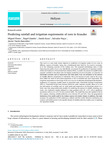Predicting rainfall and irrigation requirements of corn in Ecuador

Ver/
Use este enlace para citar
http://hdl.handle.net/2183/34266
A non ser que se indique outra cousa, a licenza do ítem descríbese como Atribución-NoComercial-SinDerivadas 4.0 International (CC BY-NC-ND)
Coleccións
- Investigación (FIC) [1654]
Metadatos
Mostrar o rexistro completo do ítemTítulo
Predicting rainfall and irrigation requirements of corn in EcuadorData
2023-08Cita bibliográfica
M. Flores, Á. Llambo, D. Loza, S. Naya, and J. Tarrío-Saavedra, "Predicting rainfall and irrigation requirements of corn in Ecuador", Heliyon, Vol. 9, issue 8, August 2023, article number e18334, doi: 10.1016/j.heliyon.2023.e18334
Resumo
[Abstract]: This work is a case study whose objective is prediction of irrigation needs of corn crops in different regions of Ecuador; being this a fundamental basic food for the country's economy, as in the remaining countries of the Andean area. The proposed methodology seeks to help improving the quality of corn crop. Specifically, we propose the application of regression models, within the framework of Functional Data Analysis (FDA), to predict the amount of rainfall (scalar response variable) in the places with the highest production of corn in Ecuador, as a function of functional covariates such as temperature and wind speed. From the estimation of the amount of rainfall, effective precipitation is calculated. This is the fraction of water used by the crops, from which the value of real evapotranspiration or ETc is obtained and, more importantly, the irrigation requirements at each stage of the corn crop, for its adequate physiological development. Application of regression models based on functional basis, Functional Principal Components (FPC) or Functional Partial Least Squares (FPLS) for scalar response variable, allows us to use the information of variables such as wind speed and temperature (of functional nature) in a better way than using multivariate models, for predicting the amount of rainfall, obtaining, as a result, very explicative models, defined by a high goodness of fit (R2=0.97, with 6 significant parameters and an error of 0.14) and practical utility. The model has been also applied to North Peru regions, obtaining rainfall prediction errors between 9% and 22%. Thus, the geographical limitations of the model could be the Andean regions with similar climate. In addition, this study proposes the application of FDA exploratory analysis and FDA outlier detection techniques as a common and useful practice in the specific domain of rainfall prediction studies, prior to applying the regression models.
Palabras chave
Corn
Crop irrigation
Effective rainfall
Evapotranspiration
Functional data analysis
Regression
Crop irrigation
Effective rainfall
Evapotranspiration
Functional data analysis
Regression
Versión do editor
Dereitos
Atribución-NoComercial-SinDerivadas 4.0 International (CC BY-NC-ND)






